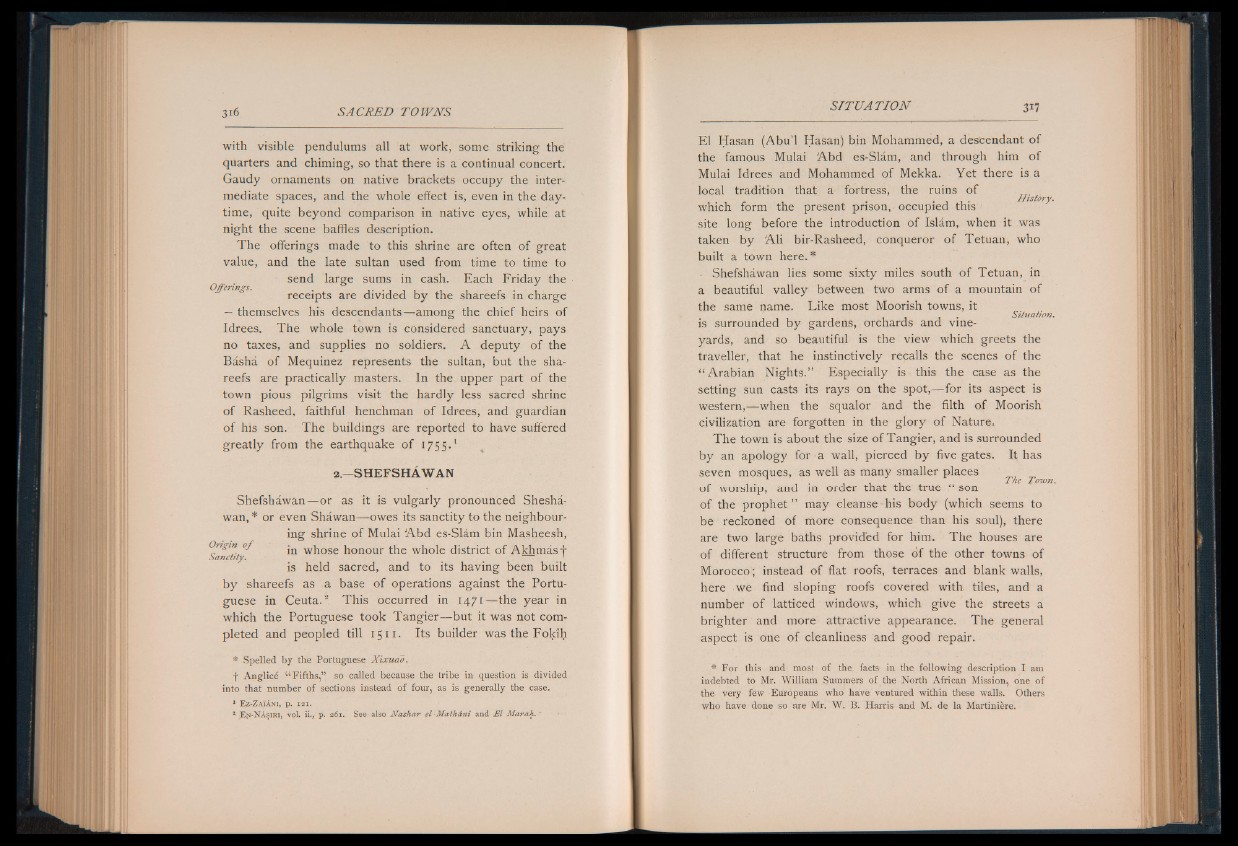
with visible pendulums all at work, some striking the
quarters and chiming, so that there is a continual concert.
Gaudy ornaments on native brackets occupy the intermediate
spaces, and the whole effect is, even in the daytime,
quite beyond comparison in native eyes, while at
night the scene baffles description.
The offerings made to this shrine are often of great
value, and the late sultan used from time to time to
send large sums in cash. Each Friday the
Offerings.
receipts are divided by the shareefs in charge
— themselves his descendants— among the chief heirs of
Idrees. The whole town is considered sanctuary, pays
no taxes, and supplies no soldiers. A deputy of the
Basha of Mequinez represents the sultan, but the shareefs
are practically masters. In the upper part of the
town pious pilgrims visit the hardly less sacred shrine
of Rasheed, faithful henchman of Idrees, and guardian
of his son. The buildings are reported to have suffered
greatly from the earthquake of 1755.1
2—SHEFSHAWAN
Shefshawan— or as it is vulgarly pronounced Shesha-
wan, * or even Shawan— owes its sanctity to the neighbouring
shrine of Mulai Abd es-Slam bin Masheesh,
Origin ° f ¡n whose honour the whole district of Akhmasf
Sanctity. _ < < 1
is held sacred, and to its having been built
by shareefs as a base of operations against the Portuguese
in Ceuta. 2 This occurred in 1471— the year in
which the Portuguese took Tangier— but it was not completed
and peopled till 1511. Its builder was the Fokih
* Spelled by the Portuguese Xixuao.
t Anglic^ “ Fifths,” so called because the tribe in question is divided
into that number of sections instead of four, as is generally the case.
1 E z - Z a i 'a n i , p . 1 2 1 .
2 E n - N a s i r i , v o l . i i . , p . 2 6 1 . See* a l s o N a s h a r e l - M a t h d n i a n d E l M a r a h .
El Hasan (Abu'l Hasan) bin Mohammed, a descendant of
the famous Mulai Abd es-Slam, and through him of
Mulai Idrees and Mohammed of Mekka. Yet there is a
local tradition that a fortress, the ruins of
History.
which form the present prison, occupied this
site long before the introduction of Islam, when it was
taken by Ali bir-Rasheed, conqueror of Tetuan, who
built a town here.*
- Shefshawan lies some sixty miles south o f Tetuan, in
a beautiful valley between two arms of a mountain of
the same name. Like most Moorish towns, it
. Situation.
is surrounded by gardens, orchards and vineyards,
and so beautiful is the view which greets the
traveller, that he instinctively recalls the scenes of the
“ Arabian Nights.” Especially is this the case as the
setting sun casts its rays on the spot,— for its aspect is
western,— when the squalor and the filth of Moorish
civilization are forgotten in the glory of Nature.
The town is about the size of Tangier, and is surrounded
by an apology for a wall, pierced by five gates. It has
seven mosques, as well as many smaller places
■ . The Town.
of worship, and in order that the true “ son
of the prophet” may cleanse his body (which seems to
be reckoned of more consequence than his soul), there
are two large baths provided for him. The houses are
of different structure from those of the other towns of
Morocco; instead of flat roofs, terraces and blank walls,
here we find sloping roofs covered with tiles, and a
number of latticed windows, which give the streets a
brighter and more attractive appearance. The general
aspect is one of cleanliness and good repair.
* For this and most of the facts in the following description I am
indebted to Mr. William Summers of the North African Mission, one of
the very few Europeans who have ventured within these walls. Others
who have done so are Mr. W. B. Harris and M. de la Martiniere.